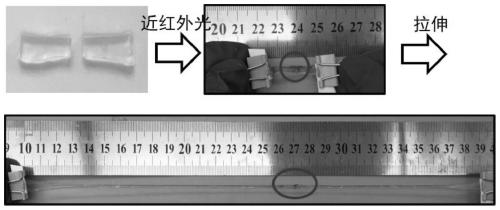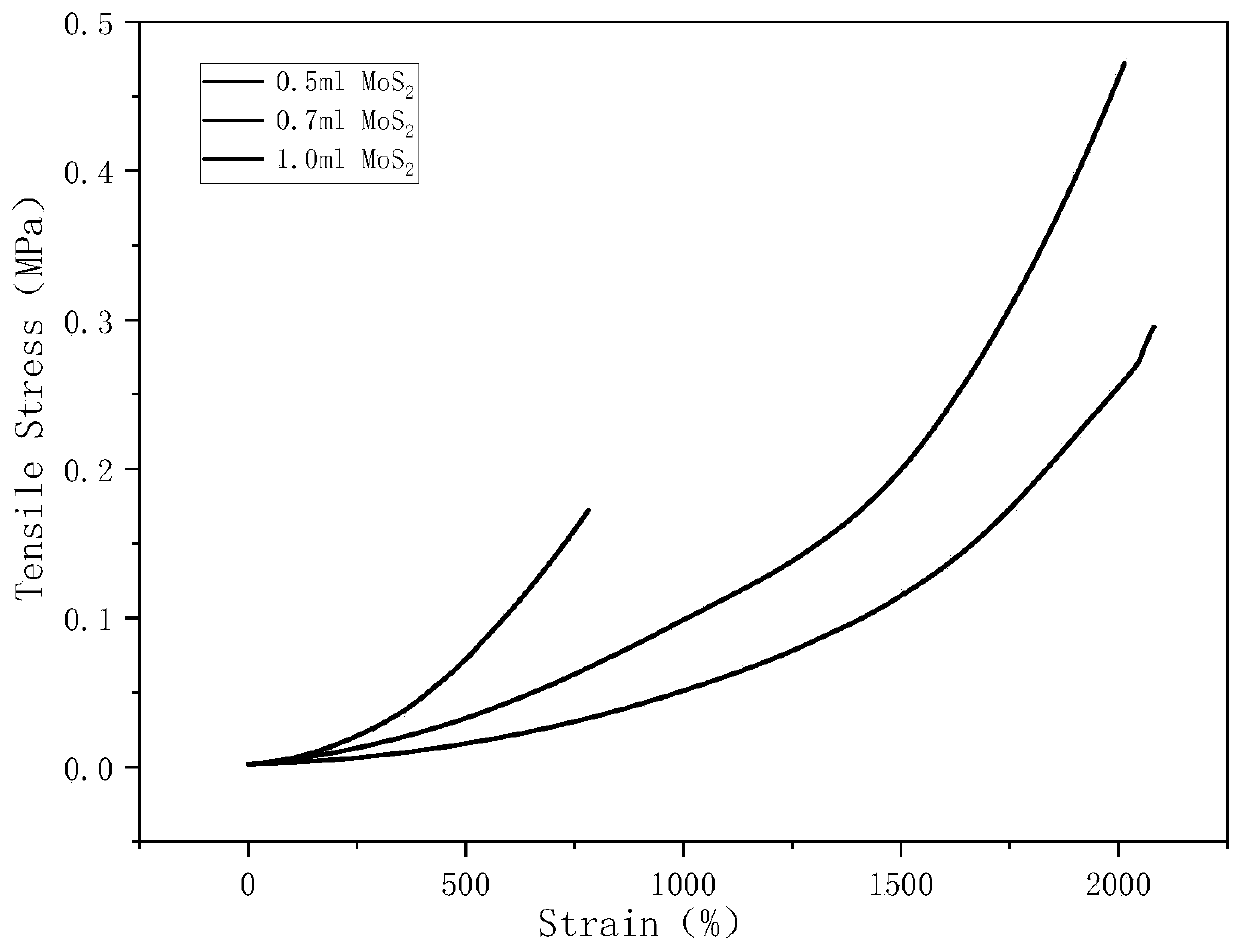Preparation method of novel photo-induced self-repairing nanometer composite hydrogel
A nano-composite, light-induced technology, applied in the field of nano-materials, can solve the problem of limited dynamic bonding of hydrogel self-healing, and achieve the effect of huge application potential and good mechanical strength
- Summary
- Abstract
- Description
- Claims
- Application Information
AI Technical Summary
Problems solved by technology
Method used
Image
Examples
Embodiment 1
[0022] 1. Preparation of functionalized molybdenum disulfide nanosheets
[0023] The functional modifier is added to the molybdenum disulfide nanosheet dispersion, and ultrasonicated for 1 hour at room temperature to obtain a surface-modified metal nanomaterial dispersion; the functional modifier is a compound containing an S atom and a carbon-carbon double bond, preferably N , N-bis (acryloyl) cystamine, the addition amount is 0.5mg. The concentration of the molybdenum disulfide nanosheet dispersion is 1 mg / mL, the concentration of the molybdenum disulfide nanosheet dispersion is 1 mg / mL, and the addition amount is 0.5 ml.
[0024] 2. Preparation of nanocomposite hydrogels
[0025] Add 1 g of hydrophilic monomer N-isopropylacrylamide monomer to the functionalized molybdenum disulfide nanosheet dispersion obtained in step 1, add 15 mg of KPS initiator after ultrasonic dissolution, 20 μL N, N, N, N- Tetramethylethylenediamine was used as a catalyst, and then placed in an ice-...
Embodiment 2
[0027] 1. Preparation of functionalized molybdenum disulfide nanosheets
[0028] Add the functional modifier to the molybdenum disulfide nanosheet dispersion after the adsorption sites have been enlarged, and ultrasonicate for 1 hour at room temperature to obtain a surface-modified metal nanomaterial dispersion; the functional modifier contains S atoms and carbon-carbon double bonds The compound, preferably N,N-bis(acryloyl)cystamine, is added in an amount of 0.5 mg. The concentration of the molybdenum disulfide nanosheet dispersion is 1 mg / mL, the concentration of the molybdenum disulfide nanosheet dispersion is 1 mg / mL, and the addition amount is 0.5 mL.
[0029] 2. Preparation of nanocomposite hydrogels
[0030] Add 1 g of hydrophilic monomer N-isopropylacrylamide monomer to the functionalized molybdenum disulfide nanosheet dispersion obtained in step 1, add 15 mg of KPS initiator after ultrasonic dissolution, 20 μL N, N, N, N- Tetramethylethylenediamine was used as a cat...
Embodiment 3
[0050] 1. Comparing the preparation of molybdenum disulfide nanosheets
[0051] Add a common cross-linking agent to the molybdenum disulfide nanosheet dispersion after expanding the adsorption sites, and sonicate for 1 hour at room temperature to obtain a surface-modified metal nanomaterial dispersion;
[0052] The common crosslinking agent is a compound containing no S atom and carbon-carbon double bond, preferably N,N-bis(acryloyl)cystamine, and the added amount is 0.5 mg. The concentration of the molybdenum disulfide nanosheet dispersion is 1 mg / mL, the concentration of the molybdenum disulfide nanosheet dispersion is 1 mg / mL, and the addition amount is 0.5 mL.
[0053] 2. Preparation of nanocomposite hydrogels
[0054] Add 1 g of hydrophilic monomer N-isopropylacrylamide monomer to the comparative molybdenum disulfide nanosheet dispersion obtained in step 1, add 15 mg of KPS initiator after ultrasonic dissolution, 20 μL N,N,N,N-four Methylethylenediamine was used as a ca...
PUM
 Login to View More
Login to View More Abstract
Description
Claims
Application Information
 Login to View More
Login to View More - R&D
- Intellectual Property
- Life Sciences
- Materials
- Tech Scout
- Unparalleled Data Quality
- Higher Quality Content
- 60% Fewer Hallucinations
Browse by: Latest US Patents, China's latest patents, Technical Efficacy Thesaurus, Application Domain, Technology Topic, Popular Technical Reports.
© 2025 PatSnap. All rights reserved.Legal|Privacy policy|Modern Slavery Act Transparency Statement|Sitemap|About US| Contact US: help@patsnap.com


